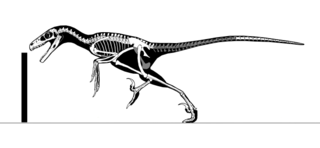
Saurornitholestes is a genus of carnivorous dromaeosaurid theropod dinosaur from the late Cretaceous of Canada (Alberta) and the United States.

Pentaceratops is a genus of herbivorous ceratopsid dinosaur from the late Cretaceous Period of what is now North America. Fossils of this animal were first discovered in 1921, but the genus was named in 1923 when its type species, Pentaceratops sternbergii, was described. Pentaceratops lived around 76–73 million years ago, its remains having been mostly found in the Kirtland Formation in the San Juan Basin in New Mexico. About a dozen skulls and skeletons have been uncovered, so anatomical understanding of Pentaceratops is fairly complete. One exceptionally large specimen later became its own genus, Titanoceratops, due to its more derived morphology, similarities to Triceratops, and lack of unique characteristics shared with Pentaceratops.
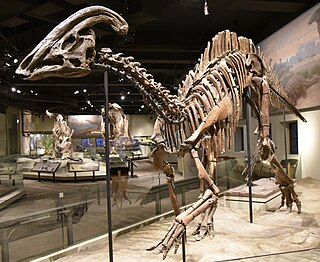
Parasaurolophus is a genus of hadrosaurid "duck-billed" dinosaur that lived in what is now western North America and possibly Asia during the Late Cretaceous period, about 76.5–73 million years ago. It was a large herbivore that could reach over 9 metres (30 ft) long and weigh over 5 metric tons, and were able to move as a biped and a quadruped. Three species are universally recognized: P. walkeri, P. tubicen, and the short-crested P. cyrtocristatus. Additionally, a fourth species, P. jiayinensis, has been proposed, although it is more commonly placed in the separate genus Charonosaurus. Remains are known from Alberta, New Mexico, and Utah, as well as possibly Heilongjiang if Charonosaurus is in fact part of the genus. The genus was first described in 1922 by William Parks from a skull and partial skeleton found in Alberta.
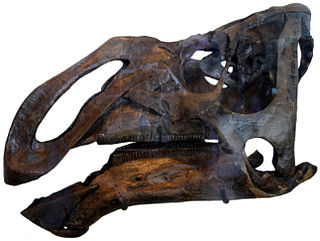
Kritosaurus is an incompletely known genus of hadrosaurid (duck-billed) dinosaur. It lived about 74.5-66 million years ago, in the Late Cretaceous of North America. The name means "separated lizard", but is often mistranslated as "noble lizard" in reference to the presumed "Roman nose".

Anasazisaurus is a genus of saurolophine hadrosaurid ("duckbill") ornithopod dinosaur that lived about 74 million years ago, in the Late Cretaceous Period. It was found in the Farmington Member of the Kirtland Formation, in the San Juan Basin of New Mexico, United States. Only a partial skull has been found to date. It was first described as a specimen of Kritosaurus by Jack Horner, and has been intertwined with Kritosaurus since its description. It is known for its short nasal crest, which stuck out above and between its eyes for a short distance.

Nodocephalosaurus is a monospecific genus of ankylosaurid dinosaur from New Mexico that lived during the Late Cretaceous in what is now the De-na-zin member of the Kirtland Formation. The type and only species, Nodocephalosaurus kirtlandensis, is known only from a partial skull. It was named in 1999 by Robert M. Sullivan. Nodocephalosaurus has an estimated length of 4.5 metres and weight of 1.5 tonnes. It is closely related and shares similar cranial anatomy to Akainacephalus.
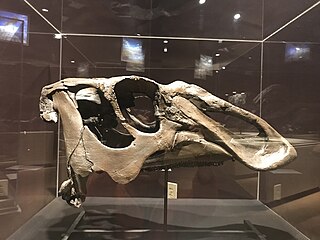
Naashoibitosaurus is a genus of hadrosaurid dinosaur that lived about 73 million years ago, in the Late Cretaceous, and was found in the Kirtland Formation of the San Juan Basin in New Mexico, United States. Only a partial skeleton has been found to date. It was first described as a specimen of Kritosaurus by Jack Horner, and has been intertwined with Kritosaurus since its description.

The Kirtland Formation is a sedimentary geological formation.

The Fruitland Formation is a geologic formation found in the San Juan Basin in the states of New Mexico and Colorado, in the United States of America. It contains fossils dating it to the Campanian age of the late Cretaceous.
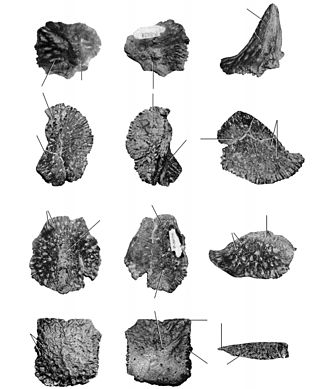
Akanthosuchus is an extinct genus of alligatoroid crocodilian, possibly an alligatorine. Its fossils are found in the Paleocene-age Nacimiento Formation of the San Juan Basin, New Mexico, USA. It is known from a partial skeleton and isolated bony armor. Its armor was distinctive, with spike-shaped and blade-shaped pieces, and it is the only known crocodilian with a combination of both.

The Ojo Alamo Formation is a geologic formation in New Mexico spanning the Mesozoic/Cenozoic boundary. Non-avian dinosaur fossils have controversially been identified in beds of this formation dating from after the Cretaceous–Paleogene extinction event, but these have been explained as either misidentification of the beds in question or as reworked fossils, fossils eroded from older beds and redeposited in the younger beds.

Titanoceratops is a controversial genus of herbivorous ceratopsian dinosaur. It was a giant chasmosaurine ceratopsian that lived in the Late Cretaceous period in what is now New Mexico. Titanoceratops was named for its large size, being one of the largest known horned dinosaurs and the type species was named T. ouranos, after Uranus (Ouranos), the father of the Greek titans. It was named in 2011 by Nicholas R. Longrich for a specimen previously referred to Pentaceratops. Longrich believed that unique features found in the skull reveal it to have been a close relative of Triceratops, classified within the subgroup Triceratopsini. However, other researchers have expressed skepticism, and believe "Titanoceratops" to simply be an unusually large, old specimen of Pentaceratops.
Dinosaur paleobiogeography is the study of dinosaur geographic distribution, based on evidence in the fossil record.

Ahshislepelta is a monospecific genus of ankylosaur dinosaur from New Mexico that lived during the Late Cretaceous in what is now the Hunter Wash Member of the Kirtland Formation. The type and only species, Ahshislepelta minor, is known only from an incomplete postcranial skeleton of a small subadult or adult individual. It was named in 2011 by Michael Burns and Robert M. Sullivan. Based on the size of the humerus, Ahshislepelta is larger than Pinacosaurus mephistocephalus but smaller than Talarurus and Pinacosaurus grangeri.

Navajodactylus is an extinct genus of pterodactyloid pterosaur from Late Cretaceous deposits of the San Juan Basin in New Mexico, United States.
Denazinemys was a genus of baenid turtle that lived in the Late Cretaceous of New Mexico. The holotype specimen, which D. nodosa was based on, USNM 8345, consists of a partial carapace and plastron. It came from the De-na-zin Member of the Kirtland Formation, and therefore, Denazinemys lived in the Kirtlandian land-vertebrate age. Many specimens other than the holotype have been assigned to Denazinemys.
Melvius is a genus of vidalamiin amiid fish from the Late Cretaceous. The type species, Melvius thomasi, was described by Bryant in 1987. A second species Melvius chauliodous, was named and described by Hall and Wolburg in 1989, and it is now considered to be one of the index taxa of the Kirtlandian land-vertebrate age. Both species of Melvius were very large at its size. A vertebral remain of M. thomasi would belongs to fish with standard length of 161 cm (5.28 ft), and there are some specimens exceeds height of that vertebra. Total length of this species would be at least 193–205 cm (6.33–6.73 ft). However, M. thomasi would be a “dwarf” compared to M. chauliodous, a specimen of M. chauliodous with abdominal centra which is 6.57 cm (2.59 in) wide would indicate standard length over 2 m (6.6 ft), and there is even larger abdominal centra which is 7.3 cm (2.9 in) wide.

Nanhsiungchelyidae is an extinct family of land turtles known from Cretaceous deposits in Asia and North America. Nanhsiungchelyids were more terrestrial than many of their contemporaries, and may have gone extinct at the end of the Cretaceous as a result.

Robert Michael "Bob" Sullivan is a vertebrate paleontologist, noted for his work on fossil lizards and dinosaurs.

Bisticeratops is a genus of chasmosaurine ceratopsian from outcrops of the Campanian age Kirtland Formation found in the Bisti/De-Na-Zin Wilderness in northwestern New Mexico, United States. The type and only species is B. froeseorum, known from a nearly complete skull.
















